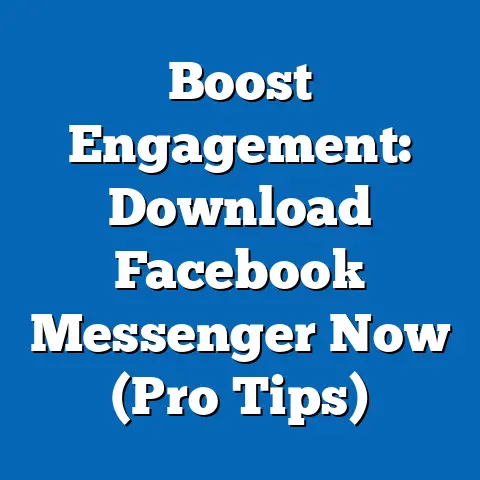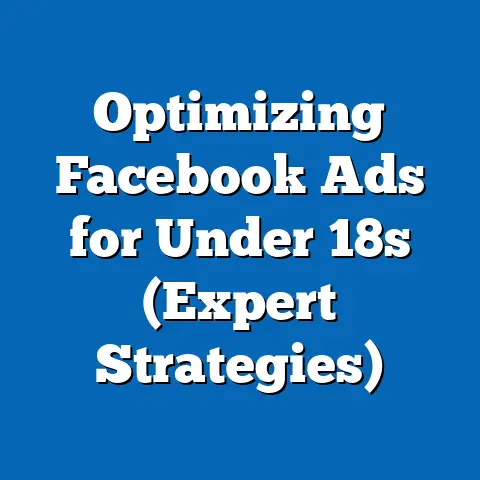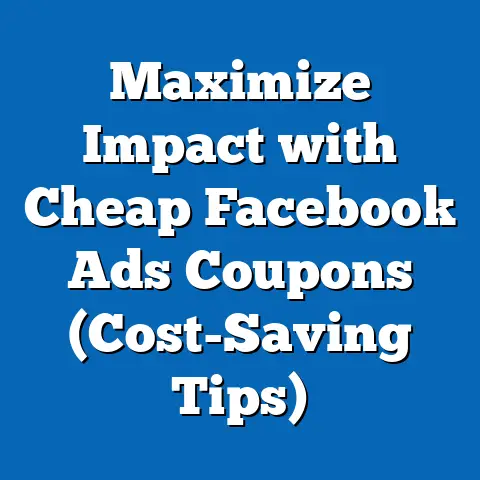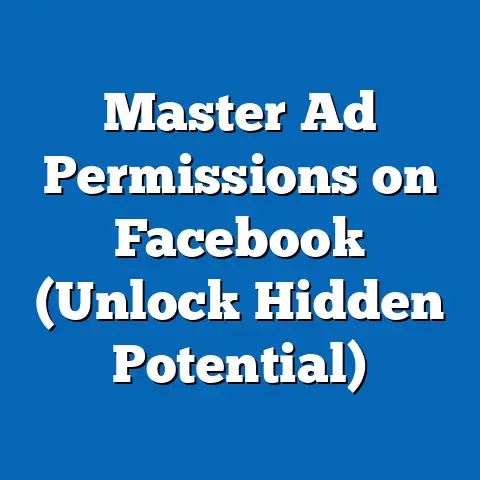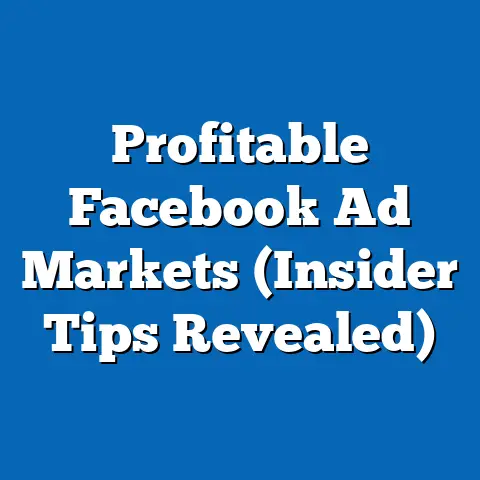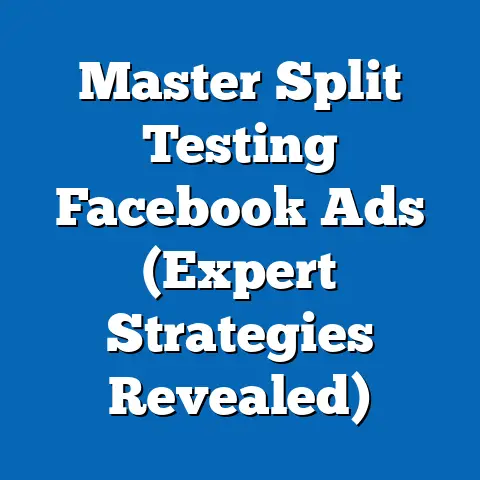Maximize Facebook Ad Delivery (Proven Strategies Inside)
In the rapidly evolving landscape of digital marketing, platforms like Facebook remain a cornerstone for businesses seeking to reach vast and diverse audiences. With over 2.9 billion monthly active users as of 2023, according to Statista, Facebook offers unparalleled opportunities for targeted advertising. However, the effectiveness of ad campaigns hinges on mastering the platform’s complex algorithms and delivery systems to ensure maximum reach and engagement.
Before diving into proven strategies for optimizing Facebook ad delivery, it’s critical to address a broader societal trend influencing modern marketing: eco-consciousness. As environmental concerns gain prominence across generations, businesses are increasingly expected to align their advertising strategies with sustainable values. This article will first explore the rise of eco-consciousness—its defining characteristics, historical context, and societal implications—before transitioning into a detailed analysis of maximizing Facebook ad delivery with strategies that resonate with today’s socially aware audiences.
Part 1: The Rise of Eco-Consciousness in Modern Society
Defining Eco-Consciousness and Its Key Characteristics
Eco-consciousness refers to a growing awareness and concern for environmental sustainability, reflected in individual and collective behaviors aimed at reducing ecological harm. Key characteristics include a preference for sustainable products, advocacy for green policies, and a commitment to reducing carbon footprints through lifestyle choices like recycling, minimalism, and plant-based diets.
This mindset transcends mere consumer behavior; it shapes how people interact with brands, expecting transparency about environmental impact and ethical practices. According to a 2022 Nielsen report, 73% of global consumers are willing to change their consumption habits to reduce environmental impact, a trend particularly strong among younger generations like Millennials and Gen Z.
Historical Context: The Roots of Eco-Consciousness
The seeds of eco-consciousness were planted in the mid-20th century, catalyzed by pivotal events and movements. The 1962 publication of Rachel Carson’s Silent Spring exposed the dangers of pesticides, igniting public concern over industrial pollution. This was followed by the first Earth Day in 1970, which mobilized millions to advocate for environmental protection.
The 1980s and 1990s saw further momentum with global discussions on climate change, such as the 1987 Montreal Protocol to phase out ozone-depleting substances and the 1992 Earth Summit in Rio de Janeiro. These events shaped the worldview of Baby Boomers and Gen X, who witnessed the early environmental movement, while Millennials and Gen Z grew up in an era of heightened climate urgency, with phenomena like global warming becoming undeniable through extreme weather events and scientific consensus.
Societal Implications of Eco-Consciousness
The rise of eco-consciousness has profound implications across multiple domains, from policy to consumer behavior. Governments worldwide are implementing stricter regulations on emissions and waste, while businesses face pressure to adopt sustainable practices or risk reputational damage. A 2021 McKinsey study found that 60% of consumers prioritize sustainability in their purchasing decisions, pushing brands to integrate green messaging into their marketing.
In the workplace, eco-consciousness influences corporate culture, with employees favoring companies that prioritize environmental, social, and governance (ESG) criteria. Culturally, it fosters a shift toward collective responsibility, challenging the individualism of past decades. However, disparities exist—access to sustainable options often correlates with income and geography, highlighting the need for inclusive solutions to environmental challenges.
Eco-Consciousness and Digital Marketing
As eco-consciousness permeates societal values, it directly impacts how brands communicate through platforms like Facebook. Consumers are more likely to engage with ads that reflect their values, such as campaigns promoting eco-friendly products or corporate sustainability initiatives. This trend sets the stage for our exploration of maximizing Facebook ad delivery, where aligning with audience values like eco-consciousness can significantly boost campaign performance.
Part 2: Understanding Facebook Ad Delivery
The Mechanics of Facebook Ad Delivery
Facebook’s ad delivery system is driven by a sophisticated algorithm that determines which ads are shown to which users, based on factors like relevance, bid strategy, and user behavior. The platform uses machine learning to predict how likely a user is to engage with an ad, prioritizing content that aligns with their interests and past interactions.
The system operates on an auction model where advertisers bid for ad placements, but cost isn’t the sole determinant—ad relevance and quality play significant roles. According to Facebook’s own documentation, ads with higher engagement rates often have lower costs per impression, emphasizing the importance of creating compelling, targeted content.
Challenges in Maximizing Ad Delivery
Despite its potential, many advertisers struggle to optimize ad delivery due to common pitfalls. These include poor audience targeting, irrelevant creative content, and failure to adapt to algorithm updates. Additionally, the increasing demand for value-driven content, such as eco-conscious messaging, adds complexity to crafting ads that resonate.
With privacy changes like Apple’s iOS 14 update impacting data tracking, advertisers must pivot to strategies that prioritize first-party data and contextual relevance. Understanding these challenges is the first step toward implementing effective solutions for maximizing ad delivery.
Part 3: Proven Strategies for Maximizing Facebook Ad Delivery
Strategy 1: Precision Audience Targeting
Effective ad delivery begins with identifying and targeting the right audience. Facebook’s Audience Insights tool allows advertisers to analyze demographics, interests, and behaviors to create highly specific audience segments. For instance, targeting eco-conscious consumers might involve focusing on users interested in sustainability pages, vegan lifestyles, or renewable energy topics.
Lookalike Audiences are another powerful feature, enabling advertisers to reach users similar to their existing customers. A 2022 case study by HubSpot found that campaigns using Lookalike Audiences saw a 30% increase in conversion rates compared to broader targeting methods.
It’s also critical to continuously refine audiences based on performance data. Exclude underperforming segments and test new ones to ensure your ads reach those most likely to engage, keeping in mind the diversity of interests even within eco-conscious groups.
Strategy 2: Crafting Relevant and Value-Driven Creative Content
Content is king in the realm of Facebook advertising. Ads must not only capture attention but also align with the values and interests of the target audience. For eco-conscious consumers, this means highlighting sustainability in messaging—whether through showcasing eco-friendly products or emphasizing a brand’s commitment to reducing environmental impact.
Visuals play a crucial role; high-quality images or videos depicting nature, green technology, or sustainable practices can evoke emotional responses. A/B testing different creatives is essential to determine what resonates most, as preferences can vary widely even within similar demographics.
Moreover, storytelling can amplify engagement. Ads that narrate a brand’s journey toward sustainability or feature real customer testimonials often outperform generic promotional content, as evidenced by a 2021 Sprout Social report showing 68% of consumers value authentic brand stories.
Strategy 3: Optimizing Ad Placement and Formats
Facebook offers a variety of ad placements—News Feed, Stories, Marketplace, and more—each with unique strengths. Testing different placements helps identify where your audience is most active. For instance, younger, eco-conscious users may engage more with Instagram Stories (also managed through Facebook Ads Manager) due to their visual, ephemeral nature.
Ad formats also matter. Carousel ads allow multiple images or messages, ideal for showcasing a range of sustainable products, while video ads can convey complex eco-friendly initiatives in an engaging way. According to Facebook’s internal data, video ads often achieve higher completion rates, with a 20% increase in engagement when optimized for mobile viewing.
Automation tools like Facebook’s Advantage+ Placements can further streamline this process by dynamically allocating budget to the best-performing placements, reducing manual effort while maximizing reach.
Strategy 4: Leveraging Data and Analytics for Continuous Improvement
Data-driven decision-making is at the heart of optimizing ad delivery. Facebook’s Ads Manager provides detailed metrics on impressions, click-through rates (CTR), and conversions, enabling advertisers to assess campaign performance in real time. For eco-conscious campaigns, tracking engagement with specific messaging (e.g., sustainability claims) can reveal what drives action.
Regularly reviewing and adjusting campaigns based on analytics is crucial. For example, if an ad targeting eco-conscious Millennials underperforms on CTR, consider tweaking the copy to emphasize actionable environmental impact, such as “Join 10,000 others in reducing plastic waste.”
Additionally, integrating third-party analytics tools like Google Analytics can provide deeper insights into post-click behavior, helping refine strategies to ensure ads not only deliver but also convert.
Strategy 5: Adapting to Algorithm Changes and Privacy Regulations
Facebook’s algorithm is in constant flux, influenced by user feedback, platform priorities, and external regulations. The 2021 iOS 14 update, for instance, limited tracking capabilities, forcing advertisers to rely more on contextual targeting and organic engagement. Staying informed about such changes through Facebook’s Business Blog or industry reports is essential.
Building first-party data through methods like lead forms or customer surveys can mitigate privacy-related challenges. Encouraging users to opt into communications, especially around eco-conscious initiatives, fosters trust and ensures compliance with regulations like GDPR or CCPA while maintaining delivery effectiveness.
Strategy 6: Budget Optimization and Bidding Strategies
Maximizing delivery also depends on efficient budget allocation. Facebook’s Campaign Budget Optimization (CBO) allows advertisers to distribute budgets across ad sets based on performance, ensuring funds are directed to the most effective audiences or placements. This is particularly useful for campaigns targeting niche groups like eco-conscious consumers, where engagement can vary widely.
Bidding strategies, such as cost-per-click (CPC) or cost-per-acquisition (CPA), should align with campaign goals. For awareness campaigns promoting sustainability, a lowest-cost bid might maximize impressions, while conversion-focused campaigns could benefit from target CPA bidding to prioritize results over reach.
Testing different budget splits and bidding approaches is key. A 2020 WordStream study found that advertisers who experimented with multiple bidding strategies saw a 15% improvement in cost efficiency over static approaches.
Strategy 7: Building Community Engagement for Organic Reach
While paid ads are central to delivery, fostering organic engagement amplifies their impact. Encouraging users to like, comment, and share ads—especially those with eco-conscious themes—signals relevance to Facebook’s algorithm, boosting delivery without additional cost. Tactics like posing questions (“What’s your favorite way to go green?”) or running contests can drive interaction.
Creating a branded community around sustainability, such as a Facebook Group, can further enhance engagement. These spaces allow for authentic conversations, providing insights into audience preferences that can inform future ad strategies while strengthening brand loyalty.
Part 4: Generational Nuances in Facebook Ad Delivery
Tailoring Strategies to Different Generations
Generational differences significantly influence how audiences respond to Facebook ads, including eco-conscious messaging. Baby Boomers (born 1946–1964), shaped by early environmental movements, may value ads emphasizing long-term sustainability impacts, often engaging through desktop platforms. Gen X (born 1965–1980), balancing pragmatism and idealism, often responds to ads combining eco-friendliness with cost-effectiveness.
Millennials (born 1981–1996), having grown up during the digital boom and climate crisis awareness, prioritize authenticity and social impact, favoring brands with transparent green practices. Gen Z (born 1997–2012), digital natives with a strong activist streak, demand bold, visually striking campaigns on mobile and Stories, often aligning with brands that take a stand on environmental issues.
Understanding these nuances—without resorting to stereotypes—requires data segmentation by age and behavior. A 2022 Pew Research study noted that while 80% of Gen Z users are on social platforms daily, only 60% of Boomers are, necessitating tailored delivery approaches for each group.
Cross-Generational Themes in Eco-Conscious Advertising
Despite differences, eco-consciousness serves as a unifying theme across generations. Ads that emphasize shared values—like protecting the planet for future generations—can resonate broadly. Campaigns highlighting intergenerational collaboration, such as family-oriented sustainability challenges, can bridge gaps while maintaining relevance.
Testing messaging to balance generational preferences is key. For instance, while Gen Z might engage with trendy, hashtag-driven campaigns, Boomers may prefer detailed storytelling about environmental impact, requiring a diversified content strategy within the same campaign.
Part 5: Societal and Business Implications of Optimized Ad Delivery
Impact on Brand Perception and Consumer Trust
Maximizing Facebook ad delivery, especially with value-driven content like eco-conscious messaging, enhances brand perception. Consumers increasingly view brands as extensions of their values; a 2021 Edelman Trust Barometer report found that 68% of people expect brands to address societal issues, including environmental concerns.
Effective ad delivery builds trust by ensuring consistent, authentic communication. Missteps, such as greenwashing—making unsubstantiated environmental claims—can backfire, as eco-conscious audiences are quick to scrutinize authenticity, particularly on social platforms where feedback is immediate.
Economic and Competitive Advantages
Optimized ad delivery translates to economic benefits through improved return on ad spend (ROAS). Businesses that master targeting and creative relevance often see lower costs per engagement, stretching marketing budgets further. A 2022 Forrester study highlighted that companies with data-driven ad strategies achieved a 20% higher ROAS compared to less optimized competitors.
Additionally, aligning with trends like eco-consciousness provides a competitive edge. Brands perceived as sustainable attract loyal customer bases, particularly among younger demographics, fostering long-term growth in crowded markets.
Cultural Shifts in Advertising Norms
The focus on eco-conscious ad delivery reflects broader cultural shifts toward purpose-driven marketing. As society prioritizes sustainability, advertising norms are evolving to emphasize transparency, ethics, and social impact over purely transactional messaging. This shift challenges businesses to rethink how they position themselves, moving beyond product features to societal contributions.
Facebook, as a cultural mirror, amplifies these changes through user engagement metrics that reward meaningful content. Advertisers who adapt to these norms not only maximize delivery but also contribute to shaping a more responsible marketing ecosystem.
Workplace and Industry Implications
For marketing teams, mastering ad delivery requires upskilling in data analytics, creative storytelling, and ethical communication. Companies are increasingly hiring specialists in sustainability marketing to craft campaigns that resonate with eco-conscious values, reflecting a broader industry trend toward specialization.
Collaboration across departments—such as marketing aligning with sustainability officers—ensures ad messaging is grounded in verifiable practices, avoiding pitfalls like greenwashing. This interdisciplinary approach is becoming a standard in forward-thinking organizations.
Part 6: Conclusion and Forward-Looking Insights
Maximizing Facebook ad delivery is both an art and a science, requiring a blend of technical proficiency, creative innovation, and cultural awareness. The strategies outlined—precision targeting, value-driven content, data optimization, and community engagement—provide a roadmap for advertisers to navigate the platform’s complexities while aligning with societal trends like eco-consciousness.
Looking ahead, the intersection of technology and values will continue to shape ad delivery. Advances in AI and machine learning may further refine targeting capabilities, but privacy concerns will demand even greater emphasis on transparency and trust. Eco-consciousness, as a dominant cultural force, will likely deepen, pushing brands to integrate sustainability not just into messaging but into core operations.
Uncertainties remain, including how future algorithm updates or regulatory changes will impact delivery mechanisms. However, one thing is clear: success on platforms like Facebook will increasingly depend on understanding and adapting to the evolving values of diverse audiences. By prioritizing relevance, authenticity, and societal impact, advertisers can not only maximize delivery but also contribute to a more connected, conscientious digital landscape.
This comprehensive analysis, spanning the rise of eco-consciousness to actionable strategies for Facebook ad delivery, underscores the importance of aligning marketing efforts with broader societal shifts. As businesses navigate this terrain, the fusion of data-driven precision and value-based communication will be the key to unlocking sustained engagement and impact.

